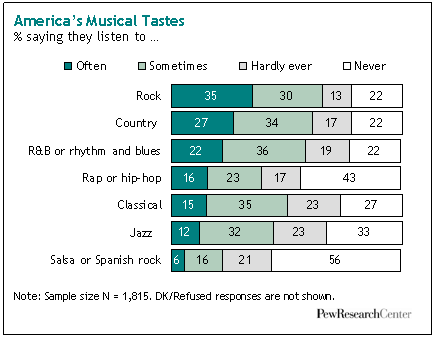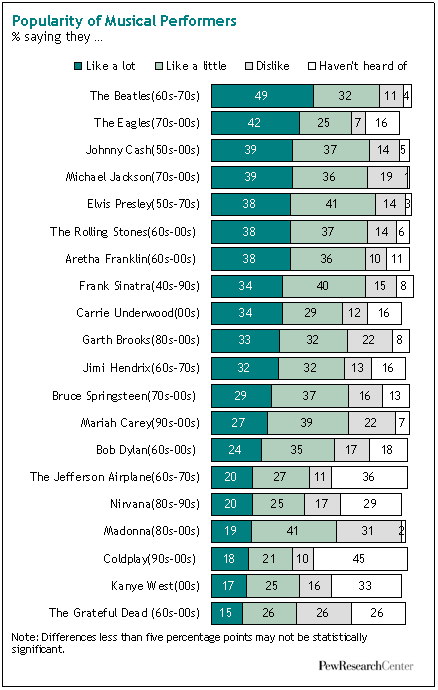Around the time of Woodstock, rock and roll wasn’t very popular. In a 1966 Harris Survey, it was near the very back of the pack among 11 musical styles tested.5 Not only that, but nearly half the public (44%) said in that survey that they actively disliked rock; the next highest genre on this “dislike” scale was opera at just 17%.
How times have changed.
 Rock and roll today is the most popular music in the country, with nearly two-thirds of the public in the Pew Research survey saying they often (35%) or sometimes (30%) listen to it. Country comes in a close second — 27% often listen to it; 34% sometimes do. Rounding out the list are rhythm and blues (22% often); rap or hip-hop (16% often); classical (15% often); jazz (12% often) and salsa or Spanish rock (6% often).
Rock and roll today is the most popular music in the country, with nearly two-thirds of the public in the Pew Research survey saying they often (35%) or sometimes (30%) listen to it. Country comes in a close second — 27% often listen to it; 34% sometimes do. Rounding out the list are rhythm and blues (22% often); rap or hip-hop (16% often); classical (15% often); jazz (12% often) and salsa or Spanish rock (6% often).
The ascendancy of rock over the decades is partly a story of changing tastes. It’s also, in part, a story of generational replacement. To put it bluntly, one reason rock has been able to march up the charts over the years is that many of the older adults who found it so distasteful in the 1960s are no longer around.
But that’s only half of the generational dynamic behind rock’s rise. The other half has to do with the extent to which today’s young adults have inherited their boomer parents’ fondness for rock. (The irony is that while the music has largely stayed the same, its generational and cultural context has flipped. For boomers, rock was a rebellion. For their children, it’s mainstream.)
The age patterns in the accompanying table tell both halves of this generational story. Rock is the favorite musical style of those ages 16 to 29, 30 to 49 and 50 to 64. The only age group that doesn’t like rock the best is adults ages 65 and older. Among this group, just 8% say they listen to rock often — placing the genre fifth out of seven styles tested.
Rock is hardly the only genre for which tastes are different across different generations. Hip-hop is the second favorite genre of those ages 16 to 29, the fourth favorite of those ages 30 to 49 and the least favorite of everyone over 50. Indeed, the age breakdown of hip-hop’s fan base is probably not much different from what rock’s was a generation or two ago, though it remains to be seen if this newer style will be able to match rock’s long march to the top.

For country music, the approval ratings by age pattern run in the opposite direction. It is the favorite style of adults ages 65 and older, the second favorite of those ages 50 to 64, the third favorite of those ages 30 to 49 and the fourth favorite of those ages 16 to 29. Does that mean country is on a downward path in popularity? Once again, only time will tell.
When it comes to tastes in music, age is far from the only dividing line. Tastes also line up according to race, ethnicity, region and even party identification.
For whites, the top two genres (in order) are rock and country. For blacks, it’s R&B and hip-hop. For Hispanics, it’s salsa and rock.
Rock claims the top spot in all four regions of the country, although in the South it’s statistically tied with country.
As for political differences, Republicans favor country (slightly) over rock. Democrats put R&B and rock in a statistical dead heat. And independents go for rock, followed by country and R&B.
The Long Reign of ’60s Rock
Another way to look at the changing demography of musical tastes is through the popularity of various performers. The Pew Research surveys asked repondents to rate 20 performers6 representing different eras and musical styles, from the 1940s to the present. The list was designed to help settle (or, better yet, fuel) a musical debate that’s been kicking around since the days of Woodstock: Is the music of the ’60s really better than anything else in living memory, or is that just a conceit of the preening baby boomers who grew up on it?
 We didn’t ask respondents to rank order the performers on our list. We simply asked if they like, dislike or don’t know each of them. If they said they liked a performer, we asked if they liked that performer a little or a lot. We conducted two separate nationally representative surveys in this fashion; then we combined the findings into the various ranking charts presented in this section.
We didn’t ask respondents to rank order the performers on our list. We simply asked if they like, dislike or don’t know each of them. If they said they liked a performer, we asked if they liked that performer a little or a lot. We conducted two separate nationally representative surveys in this fashion; then we combined the findings into the various ranking charts presented in this section.
So then: Is ’60s music the fairest of them all?
No survey can provide a definitive answer, for reasons we’ll explain in a moment. But boomers can lay claim to bragging rights on at least one front: the Beatles. They won the popularity contest with an impressive showing of strength across all generations of listeners. As for the other ’60s rock bands on this list, they are scattered up and down the rankings among other legendary performers representing other eras and genres.
Now to the caveats. It needs to be acknowledged that, at least to some extent, a popularity contest like this is stacked against groups that have emerged in recent decades; they haven’t had as much time to build a following. True, the older groups had to overcome the opposite problem — tastes change and it’s easy to get swept away by the next big thing. Clearly, that’s happened to two of the iconic ’60s bands that performed at Woodstock (Jefferson Airplane and the Grateful Dead). But when it comes to the very biggest stars of the ’60s, we already know (from music sales and other cultural markers) that they’ve stood the test of time. We won’t know for many years if that’ll also be true of the newer groups. In short, the ’60s have done well in this survey, but our playing field isn’t entirely level.
That said, one of the most compelling findings in the survey is the extent to which the Millennial Generation (ages 16 to 29) embraces the music of the ’60s — including the work of groups that stopped performing long before anyone in that generation was born.
To put this in perspective: Try imagining young adults back in the 1960s putting the big jazz bands of the Roaring ’20s at the top of their list of favorites. Not very likely. But that’s the generational equivalent of what’s happening now. Among young people ages 16 to 29 in our survey, the Beatles, the Rolling Stones and Jimi Hendrix do quite well.

Who Likes Whom, by Age
Taking a broader look at the popularity of these 20 performers broken down by generation, some clear patterns emerge. Frank Sinatra tops the charts among the oldest age group but runs in the middle of the pack among all others. Elvis runs third in the two oldest groups, then falls back among those ages 30 to 49, and farther back among the 16- to 29-year-olds. Johnny Cash’s numbers are higher among the old than the young. Michael Jackson’s arc is tilted the other way. He tops the charts among those ages 16 to 29 and runs second among the 30- to 49-year-olds, then drifts down to the middle of the pack among the two older groups. More recent vintage groups such as Nirvana, Coldplay and Kanye West do well with the youngest age group but are stuck at the bottom among everyone 50 and over.
But along with these and other differences by generation, there are also some notable similarities. The Beatles rank in the top four among all four age groups. The Rolling Stones are in the top four in all but the oldest age group. Aretha Franklin is in the top five among all but the youngest age group.
Thus, a question: Might it be that one reason parents and teenage children aren’t quarreling as often now as parents and teenagers did a generation ago is that, when push comes to shove, they can always chill out together over a Beatles tune? As researchers like to say: needs further study.



